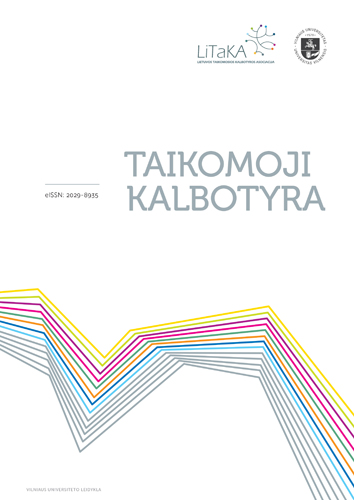Pyttipanna – tai rimta! Maisto pavadinimai – keletas pastabų rašant švedų – lietuvių kalbų žodyną
Pyttipanna – it is serious! Names for food – some comments when compiling a Swedish-Lithuanian dictionary
Author(s): Erika SausverdeSubject(s): Applied Linguistics, Lexis, Comparative Linguistics, Translation Studies
Published by: Vilniaus Universiteto Leidykla
Keywords: Swedish-Lithuanian dictionary; lexicographic practice; names for food;
Summary/Abstract: A Swede making a sandwich will use the word pålägg in reference to what s/he puts on a slice of bread – cheese, ham, sausage etc. In cafeterias in Sweden one can often come across a notice - påtår ingår ‘refill included’. How should the Swedish pålägg and påtår be rendered in Lithuanian? The paper deals with some issues of lexicographic practice arising in the process of compiling a forthcoming Swedish-Lithuanian dictionary. It will include about 30 000 word entries and a large number of expressions. Swedish-Lithuanian lexicography is a rather new field in Lithuania, which has determined the pioneering character of the present investigation. The paper aims at identifying certain tendencies in the search of equivalents to names for food. The words discussed include Swedish examples like knäckebröd, palt, pepparkaka, pyttipanna, pålägg, påtår, pölsa, wienerbröd and some others. The paper also discusses some more general issues pertaining to the field of language and food and some strategies adopted by a fiction translator and lexicographer. The examples demonstrate the complexity of the lexicographer’s task when searching for equivalents to both rather exotic and very simple Swedish dishes, which is be due to the absence of tradition of consuming the dishes by Lithuanians. Despite identical raw food products (potatoes, meat, bread), in the course of history the Swedish and the Lithuanian cuisine have taken differing paths of development and experienced different influences. In some specific cases one can find a rather precise equivalent to an ‘exotic’ dish (cf. SE pölsa, similar to EN haggis, LT košeliena). Meanwhile, a search of an equivalent to some ordinary, casual dish or food product can become a real challenge to a lexicographer resulting in a ‘near’ equivalent with a descriptive or an expository comment, cf. SE knäckebröd, EN crisp bread, LT ‘traški (švediška) duona’; SE wienerbröd, EN Danish pastry, LT ‘sluoksniuotos tešlos bandelė su įdaru’; also cf. SE pyttipanna, similar to EN hash or bubble and squeak, LT ‘patiekalas iš mėsos gabalėlių, bulvių ir daržovių (ypač apie keptus (pietų) likučius)’. The lexicographer’s demanding task requires an interdisciplinary approach, an in-depth knowledge in different fields of research, familiarity with changing culture-specific realia and attention to detail. The field of language and food is rather new in Lithuania. It opens up new interesting research perspectives to lexicography, discourse analysis, culture studies, etc.
Journal: Taikomoji kalbotyra
- Issue Year: 2012
- Issue No: 1
- Page Range: 1-15
- Page Count: 15
- Language: Lithuanian

